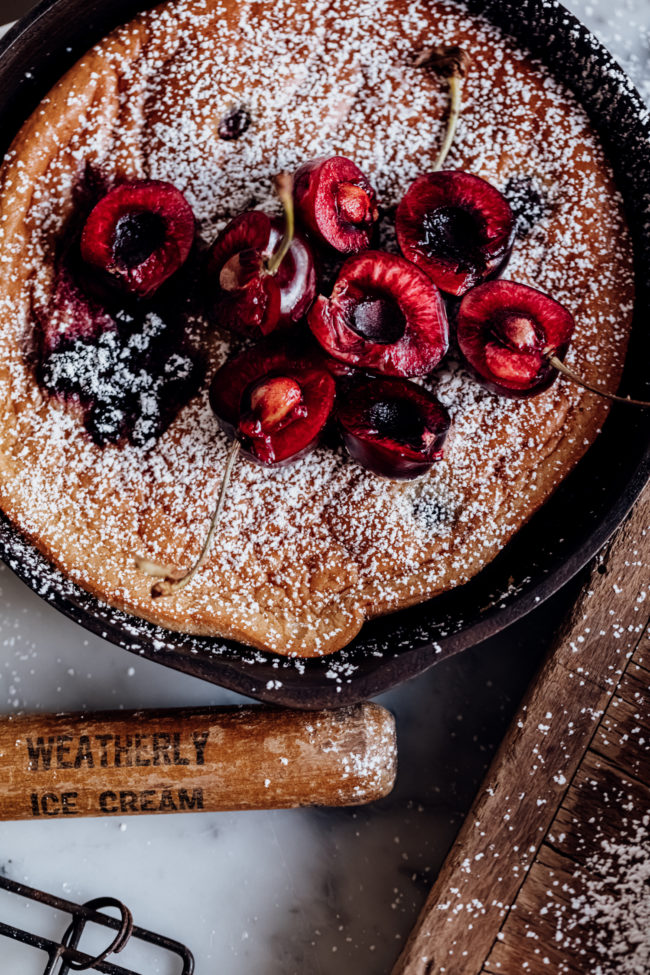
Make a stunning cherry and elderberry-studded clafoutis for your next get-together. Custardy, just sweet enough and perfect for a late summer dessert, this recipe is guaranteed to hit the right note between elegant and rustic.

What is Clafoutis (klah-foo-TEE)?
According to Williams Sonoma, a clafoutis is a classic dessert that originated in Limousin, France. Sweet black cherries are native to this region in Southern France, and classic recipes don’t call for pitting the fruit. Some people believe the pits enhance the dessert’s fragrance and flavor. We decided to skip the potential choking hazard in our recipe, but feel free to do things the old-fashioned way if you like!

Clafoutis vs. Fruit Crumble
Why make a clafoutis instead of a classic American fruit crisp or crumble? This summer dessert highlights both the natural sweetness of plump cherries and elderberries, along with plenty of spoonable, creamy custard. While I’ll always welcome a homemade berry crisp, tart or pie, there’s something unique and exotic about a fruit-dotted clafoutis.
Plus, because this dessert is less common here in the states, it’s a great opportunity to try a new recipe and impress friends and family with your pastry skills (no one will know how easy it is to make!).

Should I Use Both Cherries and Elderberries?
I added elderberries to my clafoutis recipe to put a new spin on the traditional French dish. Elderberries add a delicious tartness, a new texture, and a beautiful aesthetic to the dessert. While they cook, the berries burst open and fill the egg-based custard with their signature bright and zippy flavor.
The berries also help to balance out the sweetness of the jammy dark cherries. Of course, elderberries can be difficult to find, so you can certainly make an all-cherry clafoutis as a nod to the French chefs who invented the dish.


Cherry And Elderberry Clafoutis
Feel free to increase the fruit, lemon, and sugar here to enjoy extra topping, as most of the fruit sinks during baking. A little spoon of this on ice cream or whipped topping is an excellent way to enjoy a slice!
Note: cooking time will vary from 20-40 minutes depending on your chosen pan size. Custard is done when the center is no longer jiggly when the pan is lightly shaken. Cover partway through baking to prevent over-browning.
Ingredients
- 4 eggs, separated
- 1/2 cup organic cane sugar, divided
- 1 cup (8 fl. oz./250 ml) heavy cream
- 2 teaspoons vanilla extract
- 6 tablespoons gluten-free flour
- ⅓ teaspoon cardamom
- 3/4 pound fresh cherries, stemmed and pitted
- ¼ pound fresh elderberries stemmed and pitted
- 2 teaspoons lemon zest
- 2 teaspoons lemon juice, freshly squeezed
- 1/2 teaspoon salt
- Garnish: powdered sugar, fresh cherries
- Serve with: ice cream or whipped cream
Instructions
- Preheat the oven to 375°F. Grease 1-2 medium baking pans or a few small ramekins of your choice.
- In a mixer on medium-high speed, beat the egg yolks and ¼ cup sugar. Beat until velvety and the eggs have expanded to a light yellow color, 6-8 minutes. Add cream slowly, then vanilla, then flour and cardamom. Stop beating and scrape down the sides of the bowl, mixing again to ensure everything is incorporated.
- While the egg yolks are beating, prepare the fruit. In a medium bowl, stir together the cherries and elderberries, the remaining 1/4 cup sugar and the lemon zest and juice. Set aside.
- Wash the mixing bowl and dry. Place egg whites and salt in the bowl. Use a whisk attachment to beat on medium speed until expanded and light. Make sure to not overmix - you just want to lighten the whites here, not whip to (or near) meringue.
- Slow the speed slightly and begin to pour in the egg yolk mixture. Scrape the whole mixture in and ensure all is mixed well.
- Place the prepared baking pans in the oven to warm for a few minutes.
- When pans are heated, remove and fill with the custard mixture ⅔ full, being careful not to exceed this line, as when you put the fruit in, it will expand, and then again in the oven.
- Top the custard with fruit mixture, evenly throughout. Note: most of the fruit will sink to the bottom, that’s perfectly ok! You can reserve some fruit for serving if you like.
- Bake until the clafoutis is set in the middle, 20 to 40 minutes depending on your chosen pan size. It’s done when the center is no longer jiggly when you shake the pan lightly. If you need to (helpful for smaller ovens), cover the dish partway through baking to prevent over-browning. Serve warm with ice cream or whipped cream.

Can I Use Frozen Fruit?
Yes. In fact, you can make this summertime dessert any time of year with frozen dark sweet cherries (bonus: they come already pitted). You can also use frozen elderberries if you save some from a summer harvest.
If you use frozen berries, just let the fruit thaw fully before adding them to the custard filling. You want to drain out as much water as possible, which can weigh down the pastry.

Serving and Storing Clafoutis
This dessert is best enjoyed straight away after baking. It’s a custard made with whipped egg whites, which means that it has a tendency to fall over time. So serve your guests up generous scoops of cherry and elderberry clafoutis topped with softened vanilla ice cream or homemade whipped cream (or both!).
If you love new twists on classic sweets like this, then be sure to follow along for more on Instagram–don’t forget to say hi!























